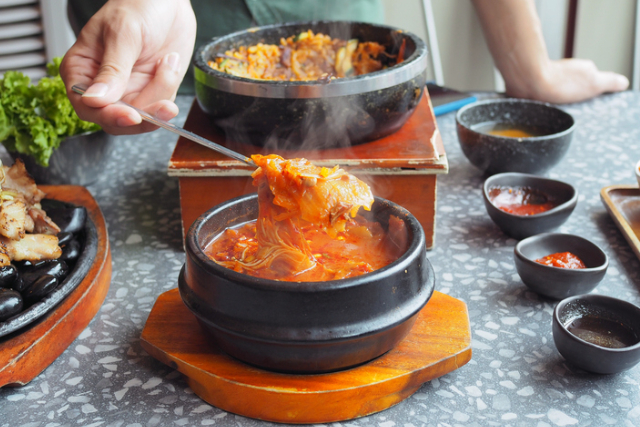If you’ve ever been a fan of anything from South Korea, your interest may have led you to dig deeper into its incredible culture and eventually, realise it is filled to the brim with many fascinating facets. From its high fashion scene to its booming entertainment industry, its exciting history to its eye-catching culture, no one can forget the rising popularity of its cuisine.
Yes, we have the delectable marinated beef, and yes, we have the delicious bibimbap. Still, you too would probably have noticed its liberal use of spices in its spicy tteokbokki, kimchi and fermented seafood like squid and octopus. While we have often been wow-ed by its savouriness and spiciness, many have never wondered why spice has been such an essential part of Korean culture. Now, wonder no further as we feed you a tidbit or two about the historical origins and trends of spice in the Korean food culture and why Korea simply loves its spices.
An Overview Of South Korea’s Spicy Food Origins
Although no one truly knows why most Korean foods are spicy, the how is far much clearer, and it is primarily due to yet another side effect of the historical Columbian Exchange. This event refers to exchanging ideas, food crops, populations, diseases, and more between the New World and the Old World following Christopher Columbus’s voyage to the Americas back in 1492.
In the seventeenth century, the exchange introduced the Mexican chilli pepper (Capsicum annuum) to Korean cuisine, which was wholly revolutionary, seeing as South Korean dishes were not notably spicier than the usual North Chinese fare prior to the Early Modern period. Another spice that reached Korean shores at the beginning of this century was the chilli pepper, albeit its reception was not positive, and it was met with general distrust due to its foreign origins. However, over the course of the seventeenth century, this view towards chilli peppers turned around, and it then became the condiment of choice throughout Korea. The spice gained popularity among all the social classes, from the elites to the urbanites of Seoul, and it has been that way since until today.
A possible idea was due to the lack of refrigeration and lack of fresh food, and the liberal use of spices can cover up mild spoilage. Spices are also used due to their antifungal and antibacterial properties and allow food to be kept edible for an extended period of time. While that time has long passed, the taste has primarily grown on the modern Korean population and remained a staple in current years.
Exactly how spicy is Korean food?
Contrary to popular belief, Korean dishes are far from being as spicy as many might think. Foods such as gochugaru and gochujang are made from Korean chilli pepper, which only has a mild rating below 2,500 Scoville units. Other dishes like fire instant noodles and tteokbokki, which is essentially rice cakes with hot pepper sauce, are intentionally made extra spicy due to the trend of spicy food challenges popular today. When comparing gochujang to raw cayenne pepper, the former definitely pales to its 30,000 unit Scoville units, and it’s easy to see just how low it is in terms of spiciness.
Why do Koreans love their spicy foods?
Koreans enthusiastically chow down on even the spiciest of foods mainly due to two reasons: 맵부심 (maebusim) and taste. Maebusim stems from the unique culture shared between South Koreans, and it means the pride of being able to stomach and handle one’s spice. Many Koreans fond of such dishes take pride in themselves for their high spice threshold and even compete with their peers. Now you know why certain products or foods cater to these people who absolutely want the spiciest of dishes.
The second reason isn’t an uncommon one. Because spicy foods inherently have a great taste when cooked well. No one would willingly torture themselves, but people all over the world enjoy that tingly sensation spicy food seem to bring them – and you’re sure they won’t do it if the food didn’t taste great in the first place.
Conclusion
Korean cuisine is known for the creative use of its spiciness, but it is generally not as over the top as others may have led you to believe. It is often a great starting point for foreigners keen to try spicy foods but have yet to try any before. The sweetness generally associated with food like tteokboki, the freshness of kimchi and the savouriness of gochujang paste goes easy on the palate when compared to other heavy uses of spices in Indian and Chinese cuisine.
Still, if you’re keen to try out spicy Korean food the next time you visit Korea, why not do so in the native language and experience the Korean culture in its entirety? Learn to make a great impression on your first meeting, or speak to the locals to ask for the best spicy dishes around. You can do this easily by enrolling in a Korean language course in Singapore before visiting South Korea the next time around!
At Sejong, we provide one of the best and most effective Korean classes on the island, backed by native Korean tutors and the “Sejong” standard of teaching praised by all our satisfied students. But don’t worry if you won’t know when you can travel to Korea, we’ll make sure to recommend you the best spicy Korean food we find in Singapore too!


